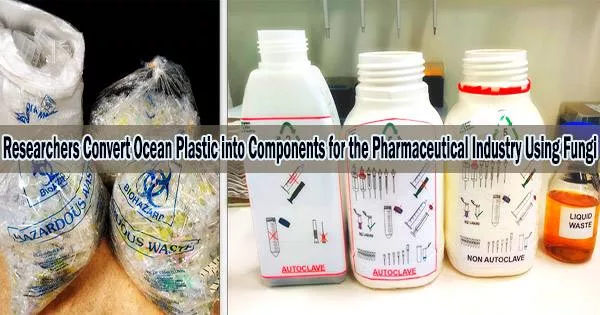Research have been exploring the use of fungi to convert plastic waste, specifically polyethylene, into useful chemicals and materials. One area of research has focused on using fungi to convert plastic into precursors for the drug industry, such as ibuprofen.
The chemical-biological method for converting polyethylene makes use of the genetically modified Aspergillus nidulans, a common soil fungus. The results were reported recently in the paper “Conversion of Polyethylenes into Fungal Secondary Metabolites” published in Angewandte Chemie, a journal of the German Chemical Society.
“What we’ve done in this paper is to first digest polyethylenes using oxygen and some metal catalysts things that are not particularly harmful or expensive and this breaks the plastics into diacids,” said co-author Berl Oakley, Irving S. Johnson Distinguished Professor of Molecular Biology at KU.
The decomposing plastics’ lengthy chains of carbon atoms were then given to genetically altered Aspergillus mushrooms. As intended, the fungi converted them into a variety of pharmacologically active chemicals, including asperbenzaldehyde, citreoviridin, and mutilin in commercially feasible yields.
Unlike previous approaches, Oakley said the fungi digested the plastic products quickly, like “fast food.”
“The thing that’s different about this approach is it’s two things it’s chemical, and it’s fungal,” he said. “But it’s also relatively fast. With a lot of these attempts, the fungus can digest the material, but it takes months because the plastics are so hard to break down. But this breaks the plastics down fast. Within a week you can have the final product.”
The KU researcher added the new approach was “bizarrely” efficient.
“Of the mass of diacids that goes into the culture, 42% comes back as the final compound,” he said. “If our technique was a car, it would be doing 200 miles per hour, getting 60 miles per gallon, and would run on reclaimed cooking oil.”
In the past, Oakley has collaborated with co-author Clay Wang of the University of Southern California to generate about a hundred secondary fungal metabolites for a range of uses.
“It turns out that fungi make a lot of chemical compounds, and they are useful to the fungus in that they inhibit the growth of other organisms penicillin is the canonical example,” Oakley said. “These compounds aren’t required for the growth of the organism, but they help either protect it from or compete with, other organisms.”
A lot of companies have done good work over the years, but it was very much incomplete because they were just growing things in the incubator and examining them for production of new compounds but 95 percent of the gene clusters were just silent since they are not ‘turned on’ until needed. They weren’t doing anything. So, there are lots more things to discover.
Berl Oakley
For a while, researchers believed they had completely utilized the ability of fungi to create these substances. But according to Oakley, the era of genome sequencing has opened up new opportunities for harnessing secondary metabolites in ways that are advantageous to both people and the environment.
“There was a realization there were lots and lots of clusters of genes that made secondary metabolites that nobody had discovered and there are millions of species of fungi,” Oakley said. “A lot of companies have done good work over the years, but it was very much incomplete because they were just growing things in the incubator and examining them for production of new compounds but 95 percent of the gene clusters were just silent since they are not ‘turned on’ until needed. They weren’t doing anything. So, there are lots more things to discover.”
Oakley’s lab at KU has honed gene-targeting procedures to change the expression of genes in Aspergillus nidulans and other fungi, producing new compounds.
“We’ve sequenced the genomes of a bunch of fungi now, and we can recognize the signatures of groups of genes that make chemical compounds,” he said. “We can change the expression of genes; we can remove them from the genome; we can do all kinds of things to them. We could see there were lots of these secondary metabolite genes clusters there and our gene-targeting procedures allowed us, at least in principle, to turn some of those clusters on.”
Oakley and Wang’s co-authors were Chris Rabot, Yuhao Chen, Swati Bijlani, Yi-Ming Chiang, and Travis Williams of USC, and Elizabeth Oakley of KU.
Due to the difficulty in recycling polyethylene polymers, researchers concentrated on creating secondary metabolites to break down these materials. For this project, they harvested polyethylenes from the Pacific Ocean that had collected in Catalina Harbor on Santa Catalina Island, California.
“There’ve been a lot of attempts to recycle plastic, and some of it is recycled,” Oakley said. “A lot of it is basically melted and spun into fabric and goes into various other plastic things. Polyethylenes are not recycled so much, even though they’re a major plastic.”
According to the KU researcher, the long-term objective of the research is to create processes that convert all plastics into items that fungi can consume, doing away with the need to sort them during recycling. He added the work is emblematic of KU’s Earth, Energy + Environment research theme, geared toward “increasing understanding to help sustain the life of our planet and its inhabitants.”
“I think everybody knows that plastics are a problem,” Oakley said. “They’re accumulating in our environment. There’s a big area in the North Pacific where they tend to accumulate. But also you see plastic bags blowing around they’re in the rivers and stuck in the trees. The squirrels around my house have even learned to line their nest with plastic bags. One thing that’s needed is to somehow get rid of the plastic economically, and if one can make something useful from it at a reasonable price, then that makes it more economically viable.”





